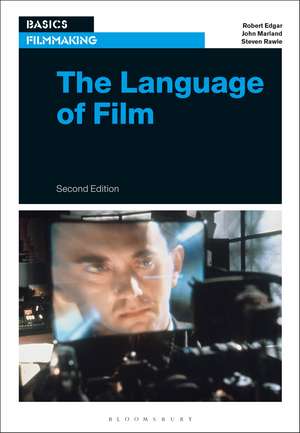The Language of Film: Basics Filmmaking
Autor Professor or Dr. Robert Edgar, Dr. John Marland, Steven Rawleen Limba Engleză Paperback – 22 aug 2018
Preț: 200.78 lei
Preț vechi: 260.40 lei
-23% Nou
38.42€ • 40.21$ • 31.98£
Carte disponibilă
Livrare economică 10-24 martie
Livrare express 21-27 februarie pentru 63.83 lei
Specificații
ISBN-10: 1501347810
Pagini: 216
Ilustrații: 75 color illus
Dimensiuni: 160 x 230 x 17 mm
Greutate: 0.54 kg
Editura: Bloomsbury Publishing
Colecția Bloomsbury Academic
Seria Basics Filmmaking
Locul publicării:London, United Kingdom
Caracteristici
Notă biografică
John Marland is Senior Lecturer in Film and Literature at York St John University, UK, where he has both taught and developed undergraduate courses in Scriptwriting.Steven Rawle is a Senior Lecturer in Film Studies at York St. John University, UK, where he teaches film form and the politics of global cultural production at undergraduate and postgraduate levels.Robert Edgar is a Senior Lecturer in the Faculty of Arts at York St John University, UK, where he teaches creative writing and film and television. Publications include Screenwriting (2009) and Directing Fiction (2010). Research projects include work on Hitchcock and Herrmann, contemporary television and Top Gear. Robert was a co-editor of The Music Documentary: Acid Rock to Electropop (2013).
Cuprins
IntroductionChapter 1: Semiotics: Images; The Visual Mind; Reading the Signs; Making Meaning; Codes and Filters; Case Study: Seven; Chapter SummaryChapter 2: Narrative: Theories of Storytelling; Structuralism; Theories of Structure; Genette's Narrative; Discourse; Music; Short Film and Narrative; Case Study: The Secret Life of Walter Mitty; Chapter SummaryChapter 3: Intertextuality: Text; Quotation; Allusion; Cult Film; Genre; Case Study: Citizen Kane; Chapter SummaryChapter 4: Ideology: Ideological Analysis; Realism; Ideology and Genre; Case Study: Dead Man's Shoes; Chapter SummaryChapter 5: Frames and Images: The Shot; Distance, Height and Framing; Shot Distances; Mise en Scène; The Mobile Camera Frame; Time and the Long Take; Case Study: Hero; Chapter SummaryChapter 6: Sound: Film: An Audiovisual Medium; Sound Properties; Diegetic and Non-diegetic Sound; Offscreen Space and Audio; The Voice; Music; Case Study: Berberian Sound Studio; Chapter SummaryChapter 7: Constructing Meaning: Continuity Editing; Discontinuity Editing; Montage; Pacing; Case Study: Psycho; Chapter SummaryConclusionFilm Language GlossaryIndexAcknowledgements and Credits
Recenzii
This exploratory reading is notably succinct, informative and moreover, digestible from a beginner's perspective.
I like the idea of having a text for this class that isn't just about the technical aspects of what a camera is and how to use it; and I really appreciate the easy to read layout and and small bites of information.
An excellent book - relevant and interesting. Written in a clear manner. The case studies make the reading more enjoyable. Great style, clear format - very well presented.
An extremely enjoyable and engaging read ... For novice film-makers complex theory is made accessible in bite-sized pieces, supported by interesting case studies and 'asides' of film fact/history.
This book provides the perfect blend between linguistic theory and visual entertainment. With its multitude of examples this edition presents core aspects of film analysis in an engaging and fun way.
A good basic text, covering simple theoretical aspects of film in relation to practice. Used in classes and on reading list for the first project in Year 1. Useful as introduction to the relationship between theory and practice.
Tastefully done, and well illustrated to highlight the points it makes ... a healthy guide to students looking for an introduction to the art of film.
Very good text and one of the best I have read on this subject.
An excellent book, brilliant resource, perfect layout.
Descriere
An effective filmmaker needs to have a good understanding of how film language works, and more importantly, how to actively influence an audience's thoughts and feelings and guide their gaze around the screen.Packed with examples from classic and contemporary cinema, The Language of Film reveals the essential building blocks of film and explains how the screen communicates meaning to its audience. You will learn about fundamental theories and concepts, including film semiotics, narrative structures, ideology, and genre, as well as how elements such as shot size, camera movement, editing technique, and color come together to create the cinematic image.With insightful case studies and discussion questions, dozens of practical tips and exercises, and a new chapter on film sound, this new edition of The Language of Film is a must-have guide for aspiring filmmakers.



